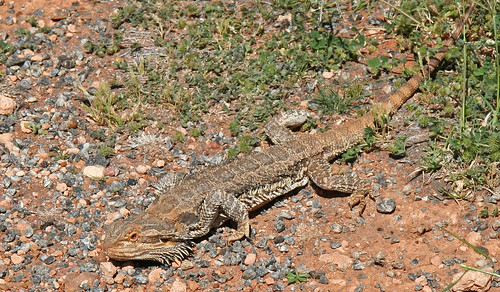Bearded dragons’ legs might turn grey for a few reasons. A possible reason is that your bearded dragon is shedding its skin. Just before the reptile sheds, the outer layer will appear gray or white.
Shedding is a natural process, and bearded dragons’ skin will dull and become greyer and puffier before they shed. Shedding is a natural part of their life cycle.
It’s normal for younger beardies to shed more than older beardies because they’re constantly growing. Your bearded dragon might also be old because they shed less.
Bearded dragons may naturally turn grey with age, or develop muted coloring. Grey beards or other skin changes are normal signs of aging.
What Causes Grey Legs in Bearded Dragons?
Bearded dragons are fascinating creatures that can make excellent pets. But just like any other animal, they can experience health issues that need to be addressed.
One of the most common issues seen in beardies is grey legs. Understanding the causes of this condition is essential to providing proper care and treatment for your pet.
Shedding Process and Retained Shed
Bearded dragons go through a shedding process several times a year as they grow. During this time, you may notice that their skin appears dull or greyish, and their legs may also turn grey.
This discoloration is usually a result of retained shed on the legs. When pieces of shed skin do not come off naturally, they can build up on the legs and cause them to appear grey.
Retained shed can be painful for your bearded dragon and cause other health problems if left untreated. Signs of retained shed include dry patches of skin, swelling around the toes or ankles, difficulty moving, and a lack of appetite or lethargy.
Fungal or Bacterial Infections
Fungal or bacterial infections can also lead to grey legs in bearded dragons. These infections are often caused by unsanitary living conditions or wounds on the skin that become infected.
Symptoms of these types of infections include redness around the affected area, swelling, discharge from wounds, lethargy, lack of appetite, and difficulty moving. If you suspect that your bearded dragon has a fungal or bacterial infection on their legs, it’s important to see a veterinarian right away for proper diagnosis and treatment.
Nutritional Deficiencies
Nutritional deficiencies can have serious consequences for bearded dragons. Here are some common nutritional deficiencies that can affect bearded dragons:
- Calcium Deficiency: Bearded dragons require calcium for proper bone growth and overall health. Insufficient calcium in their diet can lead to a condition called metabolic bone disease (MBD). Signs of calcium deficiency include soft and easily breakable bones, trouble walking, lethargy, and swollen limbs.
- Vitamin D3 Deficiency: Vitamin D3 is essential for the absorption of calcium in bearded dragons. Poor supplementation or lack of exposure to proper lighting can result in a Vitamin D3 deficiency. This deficiency can contribute to the development of metabolic bone disease.
To prevent nutritional deficiencies in bearded dragons, it is important to provide them with a balanced diet and proper supplementation. Here are some tips to ensure their nutritional needs are met:
- Offer Calcium-Rich Foods: Gut load insects, such as crickets or mealworms, with calcium-rich foods before feeding them to your bearded dragon. Leafy greens, papaya, and sweet potato are great options.
- Provide Adequate Lighting: Bearded dragons require access to UVB lighting to synthesize Vitamin D3. Ensure that their enclosure has proper UVB lighting to prevent Vitamin D3 deficiency.
- Monitor for Signs of Deficiency: Be aware of the signs of deficiency and illness in your bearded dragon. These may include trouble walking, lethargy, and swollen limbs. If you notice any changes in behavior or health, consult a veterinarian.
It is important to note that while proper diet and husbandry can help prevent nutritional deficiencies, it is always recommended to consult a veterinarian for guidance on the specific needs of your bearded dragon.
Shedding process and retained shed
Explanation of the shedding process in bearded dragons
Bearded dragons, like many other reptiles, regularly shed their skin as a way to grow and remove any old or damaged skin. In general, shedding should occur every 4-6 weeks for a healthy adult bearded dragon.
During the shedding process, the outer layer of skin will become loose and eventually slough off. This is a natural and necessary process for bearded dragons to remain healthy.
Causes and symptoms of retained shed
Retained shed is a common condition in which some portions of the old skin do not completely come off during the shedding process. This can lead to complications such as difficulty moving or even infection if left untreated.
Some causes of retained shed include dehydration, nutritional deficiencies, improper humidity levels in their environment, or sometimes just due to old age.
Symptoms of retained shed often include areas of rough or raised skin that appear dull or darker than surrounding areas on your bearded dragon’s legs or body. In more severe cases, this can lead to discoloration like grey legs due to a lack of nutrients being absorbed through the older patches on your pet’s body.
Prevention and treatment options
To prevent retained shed in your bearded dragon you should ensure they are getting adequate hydration by providing them with fresh water regularly, maintaining appropriate humidity levels between 30% – 40%, offering regular baths to help loosen any stuck patches, etc.
Bathing also provides an opportunity for owners to check for any signs or severity of potential infections. If you notice that your bearded dragon has developed grey legs due to retained shed or other reasons mentioned earlier then treatment should commence promptly.
Gently soaking your pet in warm water can help loosen any stuck patches which may come away easily when massaged gently with your fingers. Be careful not to pull on any areas of attached skin as this can cause pain and injury to the animal.
If the affected area is small, you can try using a damp cotton swab or even a soft toothbrush to remove any stubborn areas of retained shed. If the condition persists, it is best to seek professional advice from an experienced reptile veterinarian who has experience dealing with bearded dragons and their unique requirements.
Fungal or Bacterial Infections
Types of Infections That Can Affect a Bearded Dragon’s Legs
Bearded dragons are susceptible to various types of fungal and bacterial infections, which can affect their legs. One common bacterial infection is called “septicemia,” which occurs when bacteria enter the bloodstream and cause an infection.
Another type of bacterial infection in bearded dragons is “necrotic dermatitis,” which causes skin lesions that can spread to the legs. Fungal infections can also affect bearded dragons’ legs.
One common fungal infection is “dermatomycosis,” which can cause scaling, crusting, and thickening of the skin on the legs. Another fungal infection that may affect bearded dragons’ legs is “Aspergillosis,” which can cause respiratory problems and skin lesions.
Symptoms to Look Out For
If your bearded dragon’s legs appear discolored or have any unusual growths or sores, it may be a sign of an underlying fungal or bacterial infection.
Other symptoms include lethargy, loss of appetite, difficulty breathing, discharge from nostrils or mouth, and diarrhea. It is important to take quick action if you notice any unusual signs in your pet because these infections may worsen quickly if left untreated.
Treatment Options
Treatment options for fungal or bacterial infections in bearded dragons depend on the type and severity of the infection. Most treatments involve antibiotics for bacterial infections and anti-fungal medication for fungal infections.
Your veterinarian will recommend specific treatment options based on their diagnosis after conducting some tests on your pet’s stool samples and physical examination.
Common Nutritional Deficiencies That Can Cause Grey Legs in Bearded Dragons
Grey legs in bearded dragons can be caused by nutritional deficiencies, specifically a lack of calcium and/or vitamin D3.
Vitamin D3 makes it possible for the dragon’s body to absorb calcium from its digestive system, and calcium is necessary for bone development, muscle contractions, and proper egg development and reproductive health in females.
If the body becomes deficient in calcium, it starts pulling calcium from the bones, causing metabolic bone disease (MBD).
MBD is a disease that weakens the bones of bearded dragons due to a lack of calcium, vitamin D3, and phosphorus.
In addition, a direct nutritional deficiency of vitamin D3 or a lack of exposure to the UV-B light required for lizards to make vitamin D3 can cause an imbalance that leads to grey legs.
Prevention And Treatment Options
Preventing nutritional deficiencies involves ensuring your pet receives a balanced diet that provides all necessary nutrients. Provide high-quality commercial pellets along with fresh fruits like blueberries along with leafy greens such as collard greens or dandelion greens as part of their daily intake.
Supplements like Calcium powder with D3 are also essential for proper bone health. Adding this powder to their food can aid in calcium absorption and prevent MBD.
In cases of established nutritional deficiencies, a veterinarian will typically recommend oral supplements or injectables. These supplements should always be given at the direction of a veterinarian since over-supplementation can also cause health problems.
Ensuring your bearded dragon receives proper nutrition is crucial to preventing grey legs and other health issues. A balanced diet with the right protein, fat, and carbohydrate ratios along with regular supplementation can help keep your bearded dragon healthy and happy.
Conclusion
Preventing and Treating Grey Legs in Bearded Dragons
Bearded dragons are fascinating pets that require proper care, especially when it comes to their legs. Grey legs can be a sign of a serious underlying issue such as retained shed, bacterial or fungal infections, or nutritional deficiencies.
Shedding is a natural process that happens every few weeks in bearded dragons. However, if the shed is not properly removed, it can cause a retained shed and result in grey legs.
Maintaining proper hygiene and providing your pet with a healthy diet can help prevent this issue. If you notice any signs of infection or retained shed on your bearded dragon’s legs, seek medical attention from a qualified veterinarian immediately.
They can diagnose the underlying issue and recommend appropriate treatment options. The vet may also suggest regular check-ups to ensure your pet’s overall health.
The Importance of Regular Check-ups
It is vital to take your bearded dragon for regular check-ups with a veterinary professional as they can identify potential issues before they escalate into more significant problems. During these visits, the vet will examine your pet’s skin, eyes, ears, and limbs to ensure everything is functioning correctly.
Regular check-ups may also help identify any nutritional deficiencies that could lead to grey legs or other health concerns. Bearded dragons require specific diets consisting of insects, vegetables, and fruits to maintain optimal health.
Ensuring that your bearded dragon receives proper nutrition and hygiene will go a long way toward preventing grey legs. If you notice any signs of infection or retained shed on their limbs, seek veterinary attention immediately.
Always schedule regular check-ups with your vet to stay on top of any potential issues before they become more severe problems. By taking these steps towards proactive care for our beardie friends we are doing our part in ensuring their overall well-being.


